
The Legend of Zelda is an action-adventure game franchise created by the Japanese game designers Shigeru Miyamoto and Takashi Tezuka. It is primarily developed and published by Nintendo, although some portable installments and re-releases have been outsourced to Flagship, Vanpool, and Grezzo. Its gameplay incorporates action-adventure and elements of action RPG games.
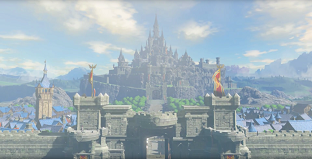
The Legend of Zelda is a video game franchise created by Japanese video game designers Shigeru Miyamoto and Takashi Tezuka and mainly developed and published by Nintendo. The universe of the Legend of Zelda series consists of various lands, the most predominant being Hyrule. The franchise is set within a fantasy world reminiscent of medieval Europe which consists of several recurring locations, races and creatures. The most prominent race in the series are the Hylians, a humanoid race with elfin features identifiable by their long, pointed ears. The series' lore contains a creation myth, several fictional alphabets, the most prominent being Hylian, and a fictional universal currency, the rupee. Most games in The Legend of Zelda series follow a similar storyline, which involves the protagonist Link battling monsters to save Princess Zelda and defeat a villain, which is often the series' main antagonist, Ganon. Nintendo developed the series' lore into a timeline that spans thousands of years across its history.

The Legend of Zelda: Ocarina of Time is a 1998 action-adventure game by Nintendo for the Nintendo 64. It was released in Japan and North America in November 1998 and in PAL regions the following month. The game is the first in The Legend of Zelda series with 3D graphics.
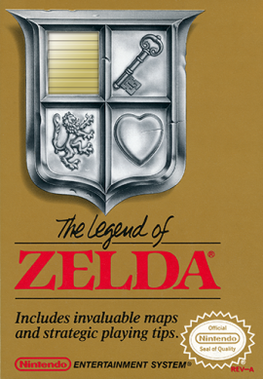
The Legend of Zelda, originally released in Japan as The Hyrule Fantasy: Zelda no Densetsu, is an action-adventure game developed and published by Nintendo. The first game of The Legend of Zelda series, it is set in the fantasy land of Hyrule and centers on an elf-like boy named Link, who aims to collect the eight fragments of the Triforce of Wisdom in order to rescue Princess Zelda from Ganon. The player controls Link from a top-down perspective and navigates throughout the overworld and dungeons, collecting weapons, defeating enemies and uncovering secrets along the way.

The Legend of Zelda: A Link to the Past is an action-adventure game developed and published by Nintendo for the Super Nintendo Entertainment System. It is the third game in The Legend of Zelda series and was released in 1991 in Japan and 1992 in North America and Europe.

The Legend of Zelda: The Wind Waker is an action-adventure game developed and published by Nintendo for the GameCube. An installment in The Legend of Zelda series, it was released in Japan on December 13, 2002, in North America on March 24, 2003, and in Europe on May 2, 2003.

Koji Kondo is a Japanese composer and pianist at the video game company Nintendo. He is best known for his contributions for the Super Mario and The Legend of Zelda series, with his Super Mario Bros. theme being the first piece of music from a video game included in the American National Recording Registry. Kondo was hired by Nintendo in 1984 as their first dedicated composer and is currently a senior executive within their Entertainment Planning & Development division.

The Triforce is a fictional artifact and icon of Nintendo's The Legend of Zelda video game franchise. It first appeared in the original The Legend of Zelda video game (1986) and has appeared in every subsequent game in the series. It consists of three equilateral triangles that are joined to form a large equilateral triangle. In the fictional history of the series, it represents the essence of the Golden Goddesses named Din, Nayru and Farore who create Hyrule. Imbued with divine power, it is capable of granting any wish to anyone who possesses it.

Princess Zelda is a character in Nintendo's The Legend of Zelda video game series. She was created by Shigeru Miyamoto for the original 1986 game The Legend of Zelda. As one of the central characters in the series, she has appeared in the majority of the games in various incarnations. Zelda is the elf-like Hylian princess of the kingdom of Hyrule, an associate of the series protagonist Link, and bearer of the Triforce of Wisdom.

Link is a character and the protagonist of Nintendo's video game franchise The Legend of Zelda. He was created by Japanese video game designer Shigeru Miyamoto. Link was introduced as the hero of the original The Legend of Zelda video game in 1986 and has appeared in a total of 21 entries in the series, as well as a number of spin-offs. Common elements in the series include Link travelling through Hyrule whilst exploring dungeons, battling creatures, and solving puzzles until he eventually defeats the series' primary antagonist, Ganon, and saves Princess Zelda.

Ganon is a character and the main antagonist of Nintendo's The Legend of Zelda video game series and franchise, as well as the final boss in many Zelda titles. In his humanoid Gerudo form, he is known as Ganondorf. A massive and malevolent porcine creature, Ganon first appeared in the original The Legend of Zelda game in 1986, while his alter ego, Ganondorf, was introduced in Ocarina of Time. He has since appeared in the majority of the games in the series in various forms. He is the archenemy of the protagonist Link and Princess Zelda of Hyrule and originally the leader of the Gerudo, a race of humanoid desert nomads before becoming the ruler of his demon army.
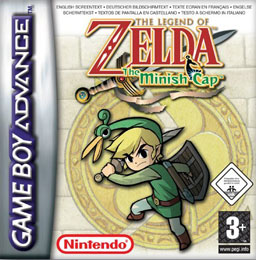
The Legend of Zelda: The Minish Cap is an action-adventure game and the twelfth entry in The Legend of Zelda series. Developed by Capcom and Flagship, with Nintendo overseeing the development process, The Minish Cap was released for the Game Boy Advance in Japan and Europe in 2004 and in North America and Australia the following year.
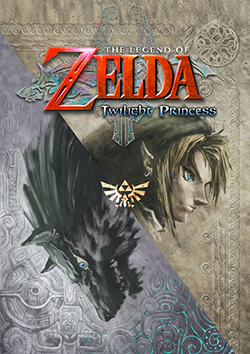
The Legend of Zelda: Twilight Princess is a 2006 action-adventure game developed and published by Nintendo for the GameCube and Wii. Originally planned for release exclusively on the GameCube in November 2005, Twilight Princess was delayed by Nintendo to allow its developers to refine the game, add more content, and port it to the Wii. The Wii version was a launch game in North America in November 2006, and in Japan, Europe, and Australia the following month. The GameCube version was released in December 2006 as the final first-party game for the console.

The Legend of Zelda: Breath of the Wild is a 2017 action-adventure game developed and published by Nintendo for the Nintendo Switch and Wii U. Set at the end of the Zelda timeline, the player controls an amnesiac Link as he sets out to save Princess Zelda and prevent Calamity Ganon from destroying the world. Players explore the open world of Hyrule while they collect items and complete objectives such as puzzles or side quests. Breath of the Wild's world is unstructured and encourages exploration and experimentation; the story can be completed in a nonlinear fashion.

The Legend of Zelda: A Link Between Worlds is a 2013 action-adventure game developed and published by Nintendo for the Nintendo 3DS. The game is the 17th in The Legend of Zelda series and is a sequel to the 1991 title The Legend of Zelda: A Link to the Past. Announced in April 2013, A Link Between Worlds was released in Australia, Europe, and North America in November, and in Japan a month later.
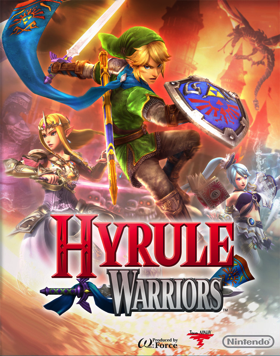
Hyrule Warriors is a 2014 hack and slash game developed by Omega Force and Team Ninja and published by Nintendo for the Wii U. The game is a collaboration between Koei Tecmo and Nintendo, mixing settings and characters from Nintendo's The Legend of Zelda with the gameplay of Koei's Dynasty Warriors series. Hyrule Warriors was released in Japan in August 2014, and worldwide the following month. It became one of the best-selling games on the Wii U. An updated port, Hyrule Warriors Legends, was released for the Nintendo 3DS in Japan in January 2016 and worldwide in March of the same year. A second enhanced port, Hyrule Warriors: Definitive Edition, was released for the Nintendo Switch in 2018. A successor, Hyrule Warriors: Age of Calamity, was released exclusively for the Nintendo Switch in November 2020.
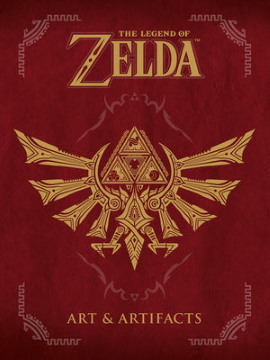
The Legend of Zelda: Art & Artifacts is an art collection book about Nintendo's The Legend of Zelda video game series. It is published in English by Dark Horse Comics out of a partnership with Nintendo and is the second book of an official series called the "Goddess Trilogy" that began with the publication of Hyrule Historia and was completed with the publication of The Legend of Zelda Encyclopedia. It was released on February 26, 2017 to celebrate the 30th anniversary of The Legend of Zelda series. The book provides a collection of illustrations created in the first 30 years of The Legend of Zelda video games. Two editions were published including a standard edition with a red cover and a purple limited edition that depicts the Master Sword on its cover.

Cadence of Hyrule: Crypt of the NecroDancer Featuring The Legend of Zelda is a rhythm game developed by Brace Yourself Games and published by Nintendo. The game is a crossover of Crypt of the NecroDancer with The Legend of Zelda, combining the rhythm-based movement and fighting mechanics with elements reminiscent of earlier games in the Zelda franchise. The game was released for the Nintendo Switch on June 13, 2019 to generally positive reviews from critics.
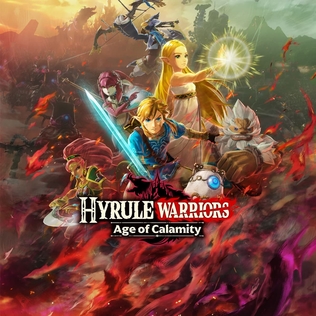
Hyrule Warriors: Age of Calamity, released in Japan as Zelda Musō: Yakusai no Mokushiroku, is a 2020 hack and slash game developed by Omega Force and published by Koei Tecmo in Japan and by Nintendo internationally for the Nintendo Switch. Like the original Hyrule Warriors (2014), Age of Calamity is a crossover that mixes the world and characters of Nintendo's The Legend of Zelda series with the gameplay of Koei Tecmo's Dynasty Warriors series, and acts as a spin-off prequel to The Legend of Zelda: Breath of the Wild (2017).
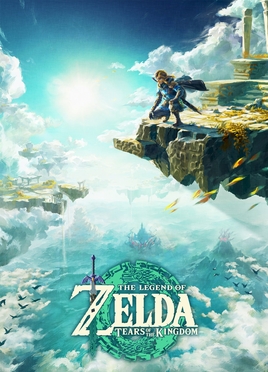
The Legend of Zelda: Tears of the Kingdom is a 2023 action-adventure game developed and published by Nintendo for the Nintendo Switch. The player controls Link as he searches for Princess Zelda and fights to prevent Ganondorf from destroying Hyrule. Tears of the Kingdom retains the open-world gameplay and setting of its predecessor, Breath of the Wild (2017), and features new environments, including an area composed of floating islands in the sky and an underground area beneath Hyrule known as the Depths. The player has access to various devices that aid in combat or exploration and can be used to construct vehicles.



















